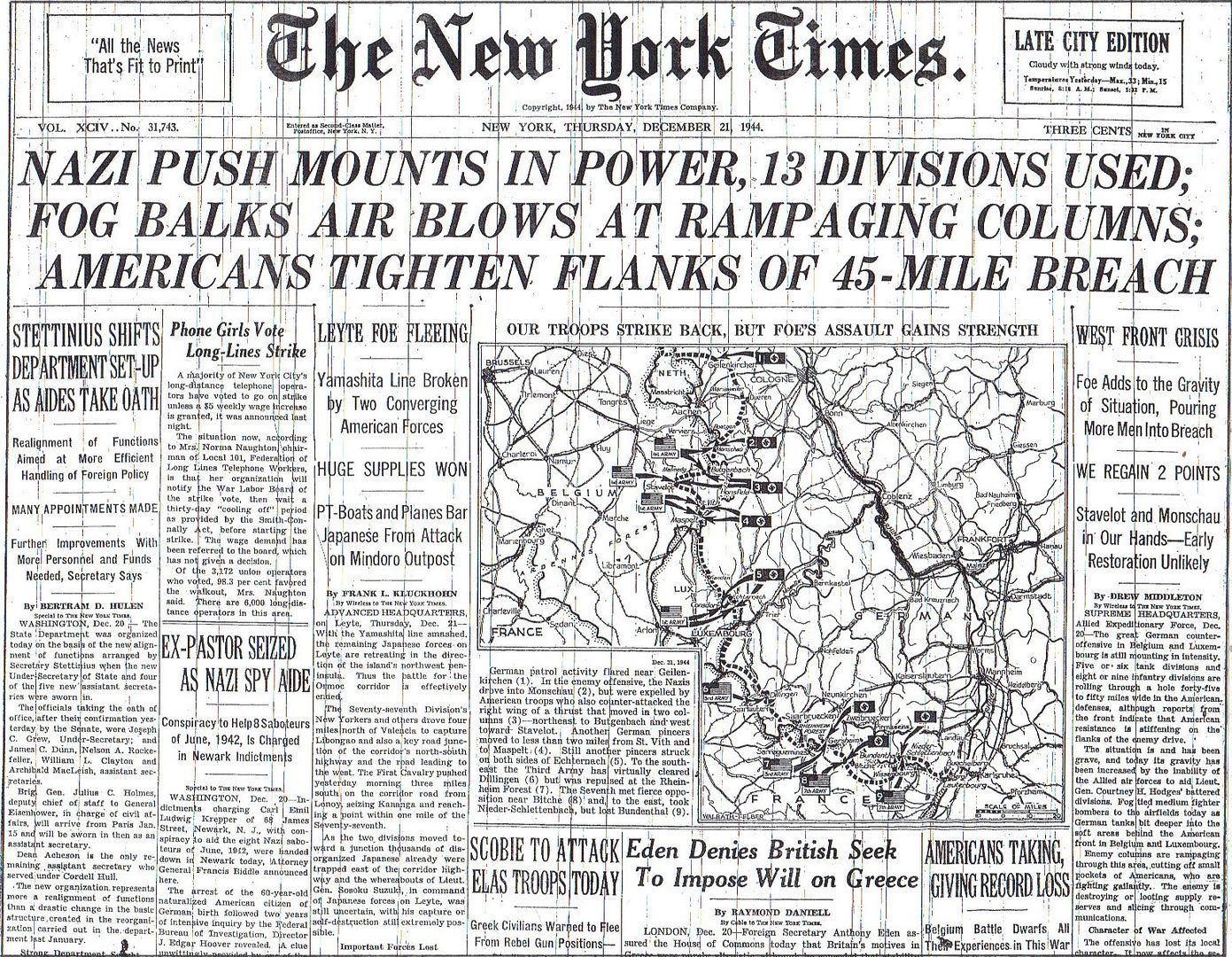
Posted on 12/21/2014 4:44:30 AM PST by Homer_J_Simpson



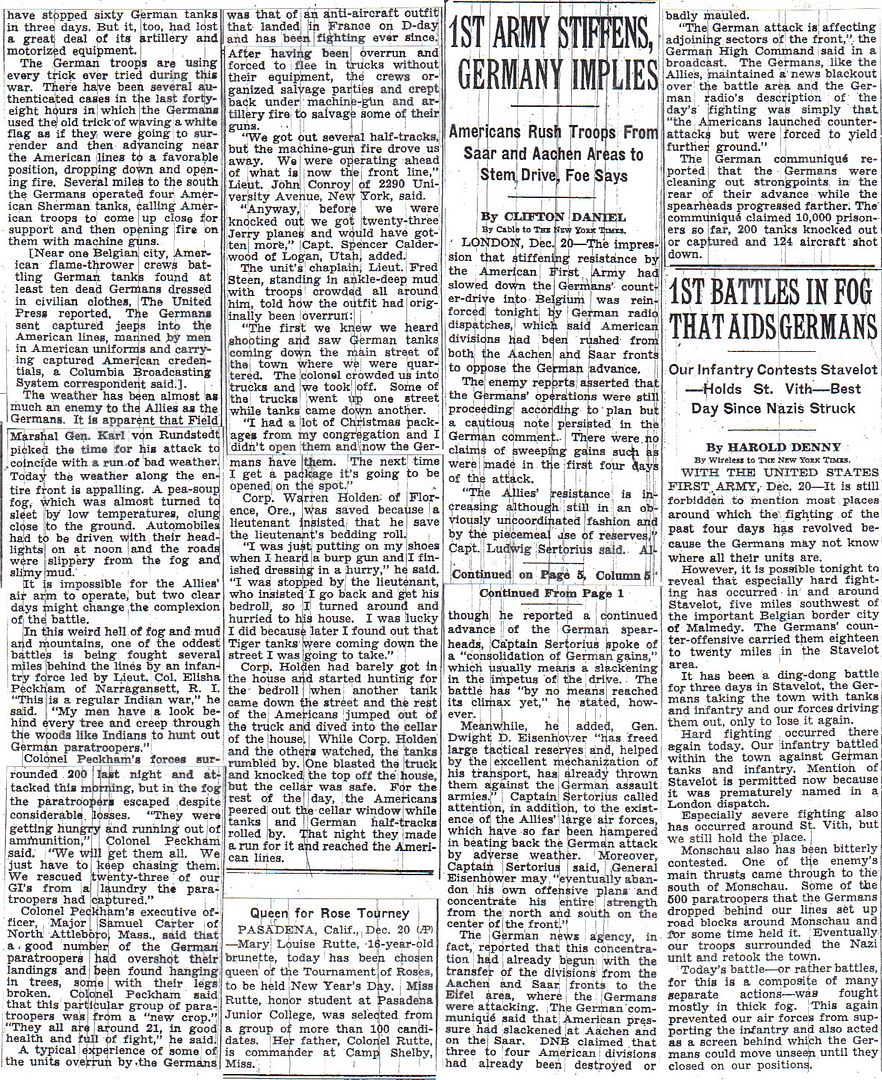
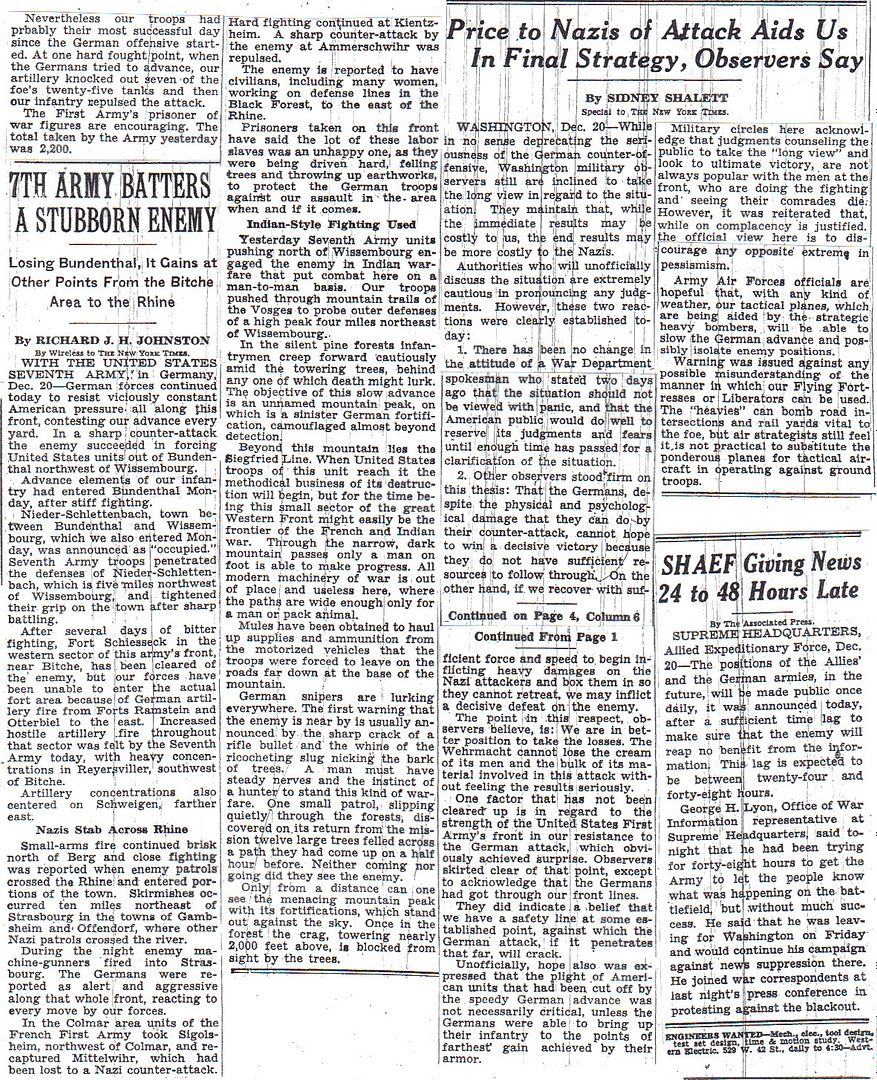

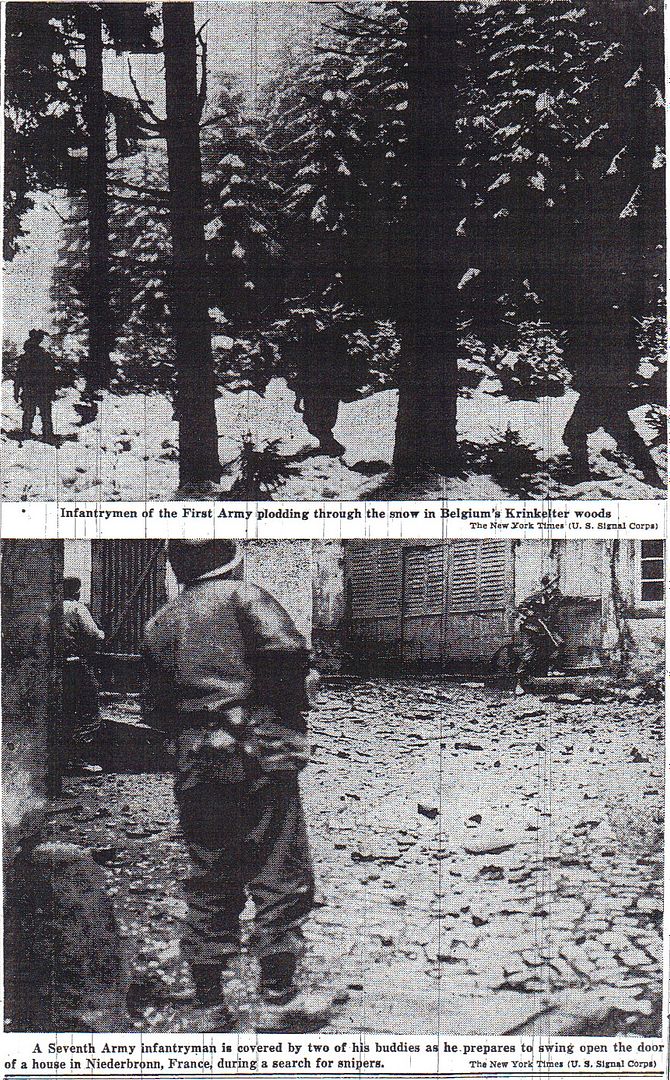
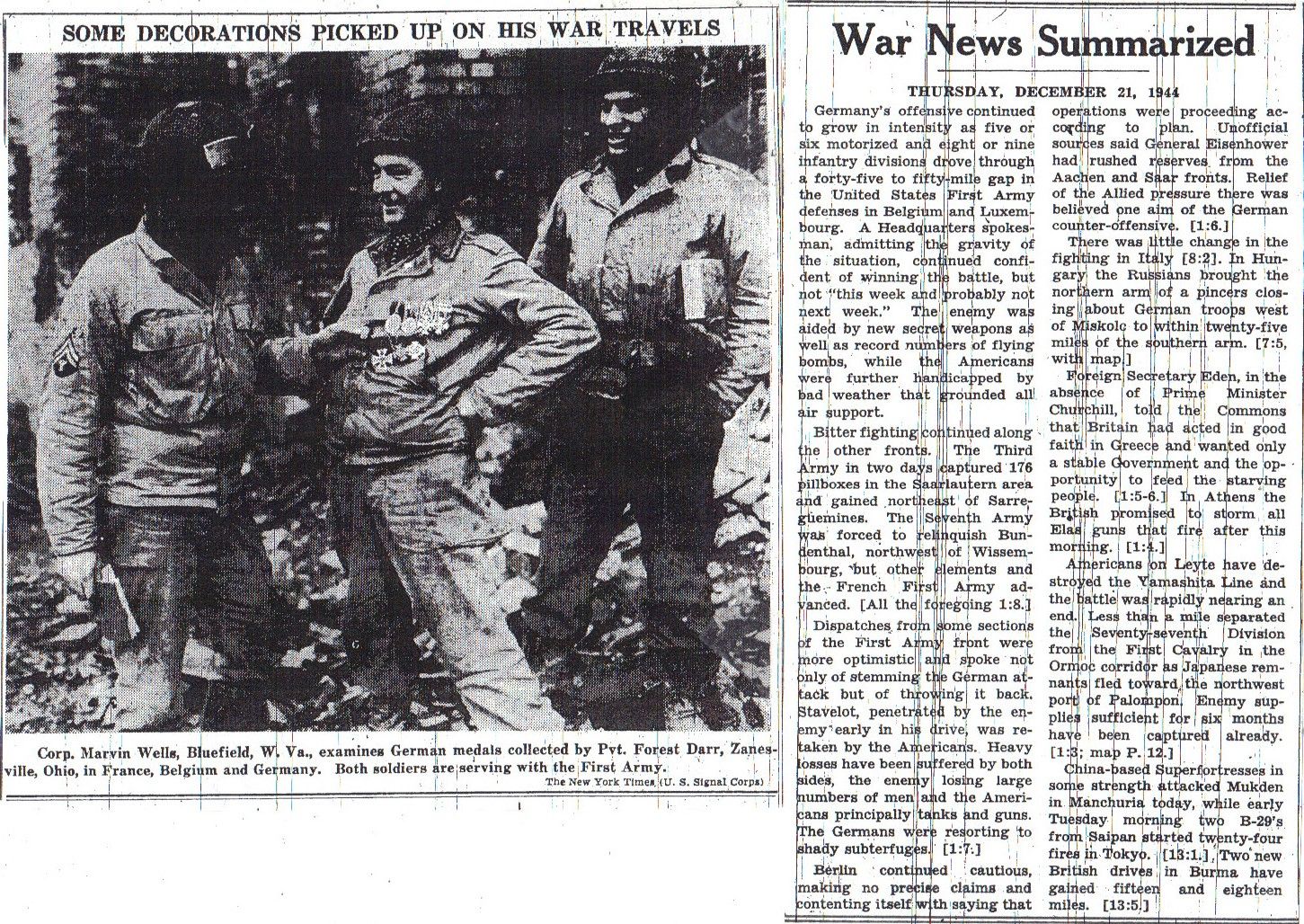
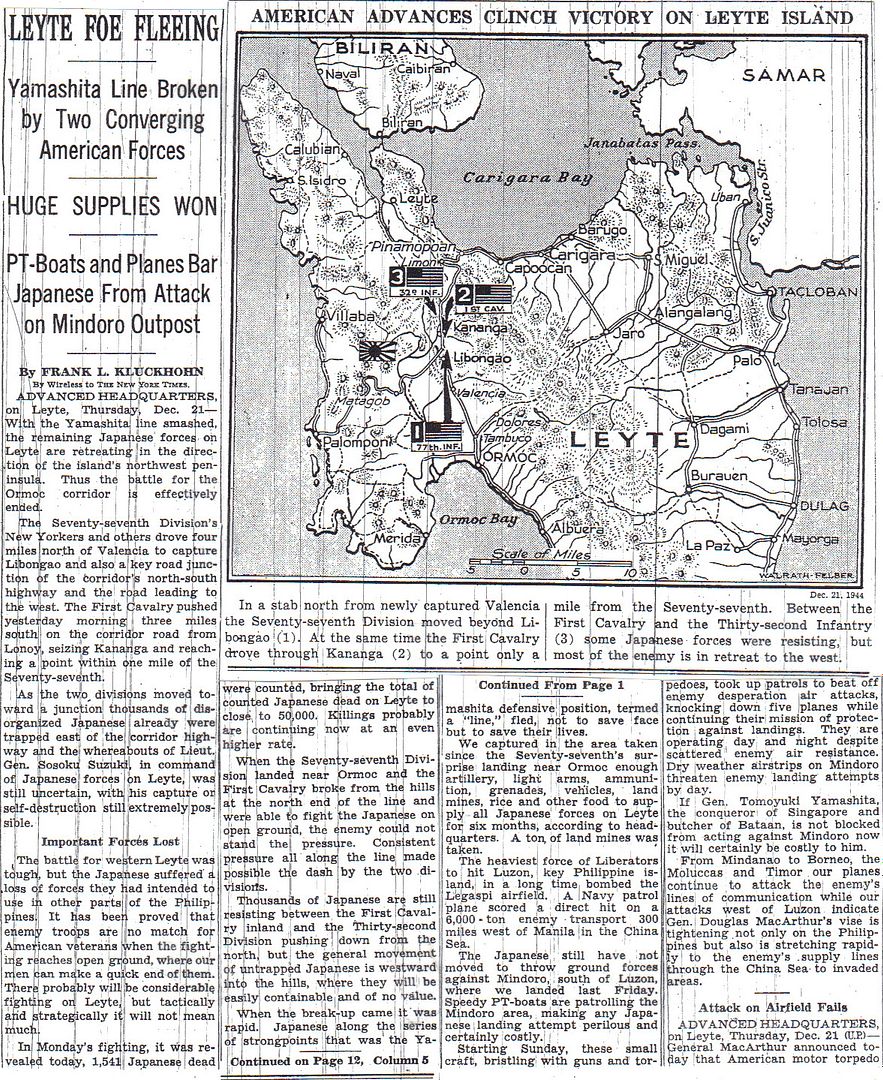
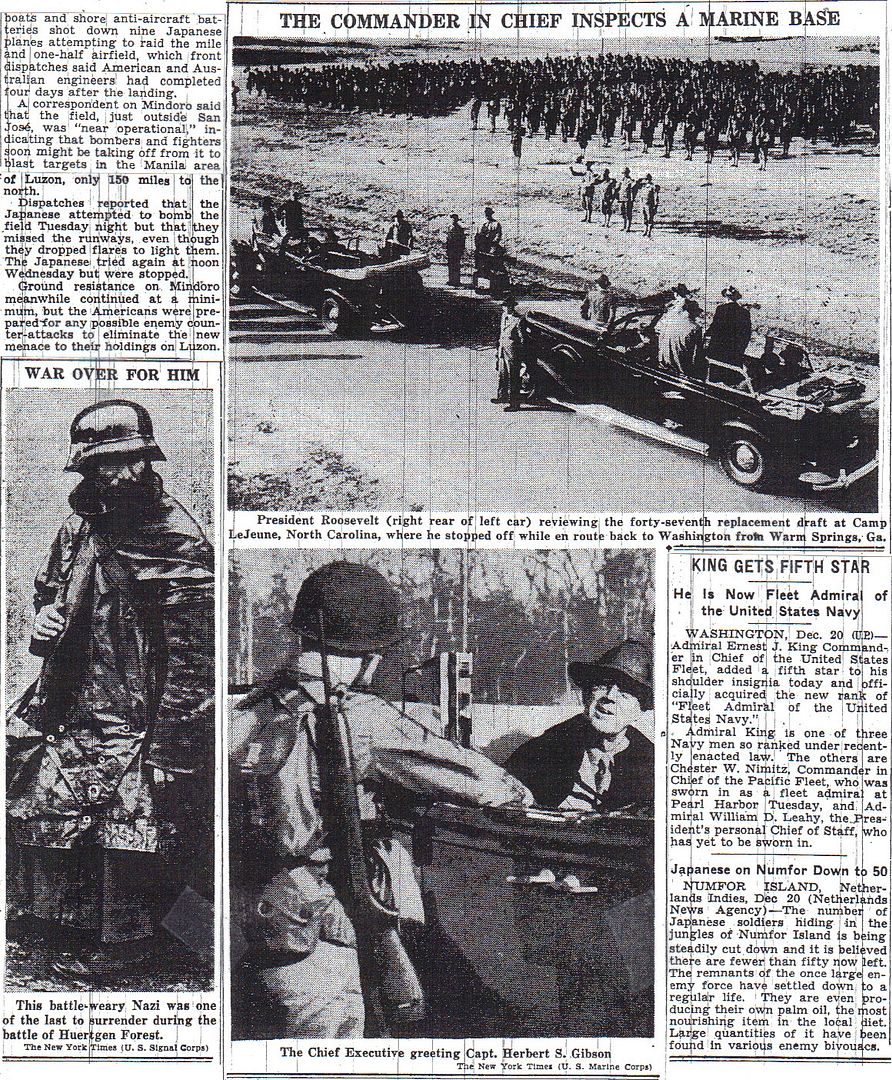
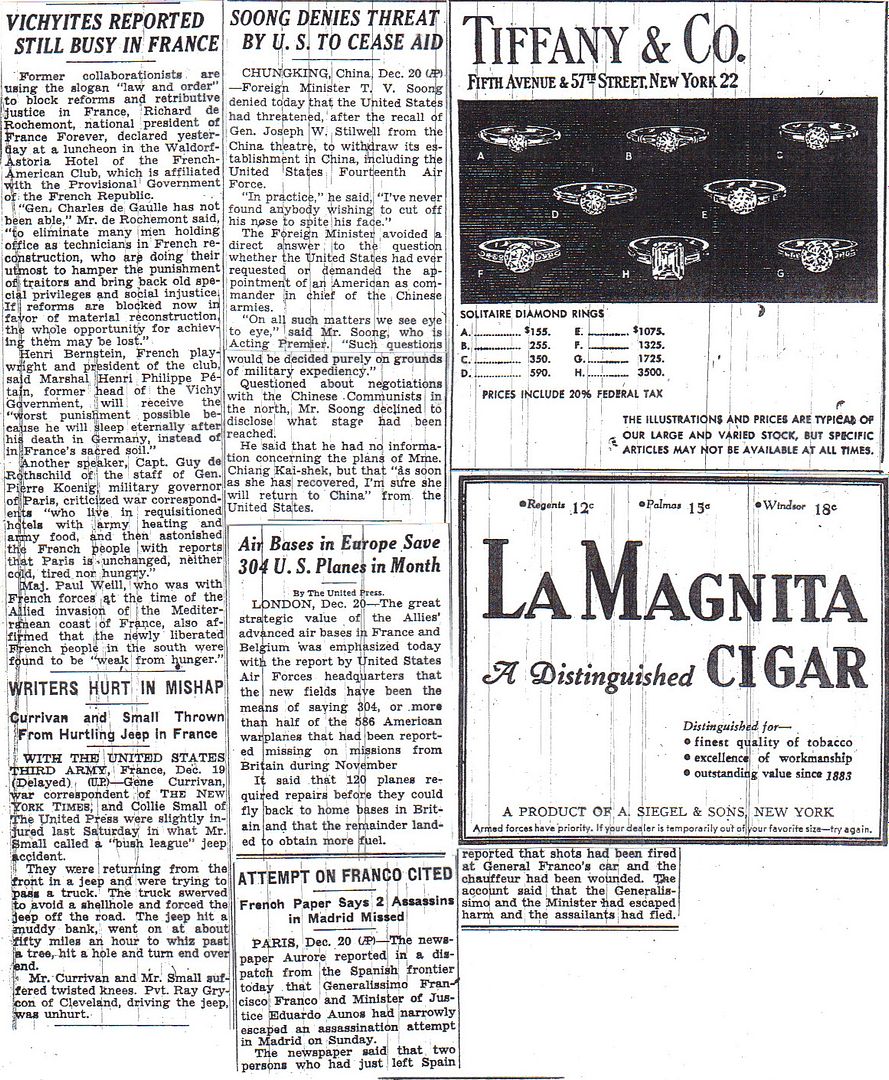
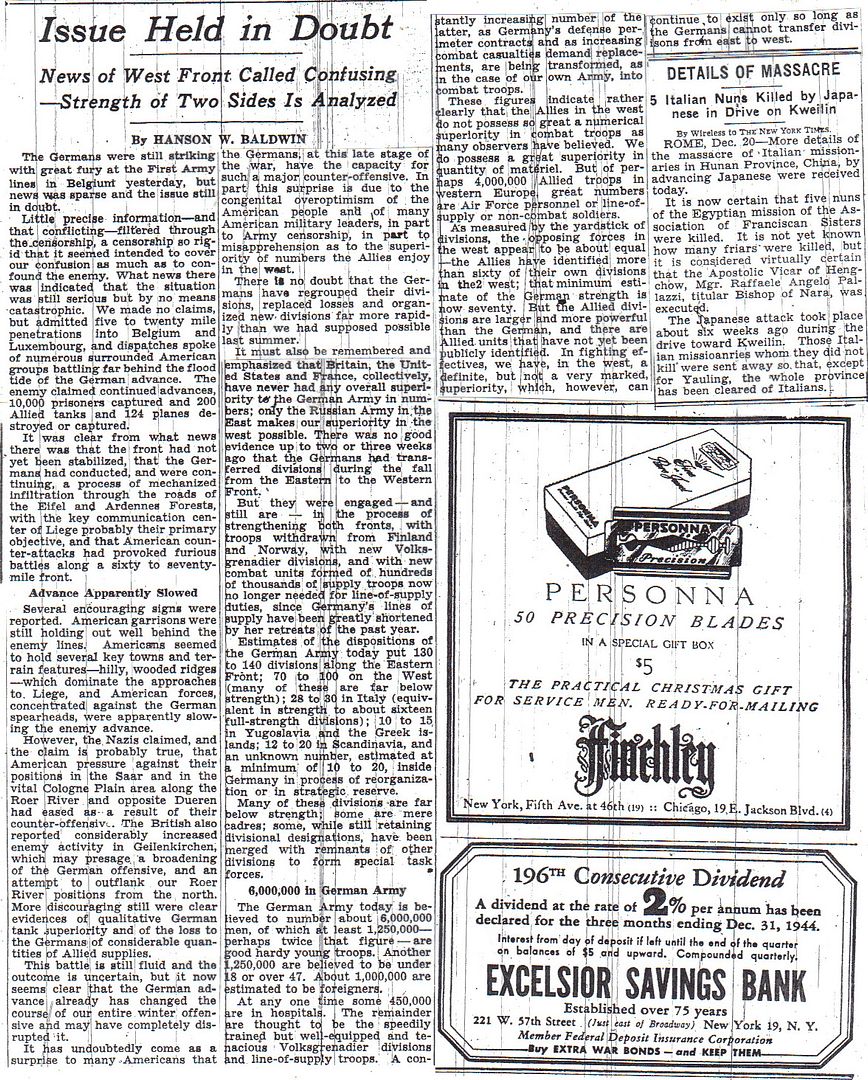
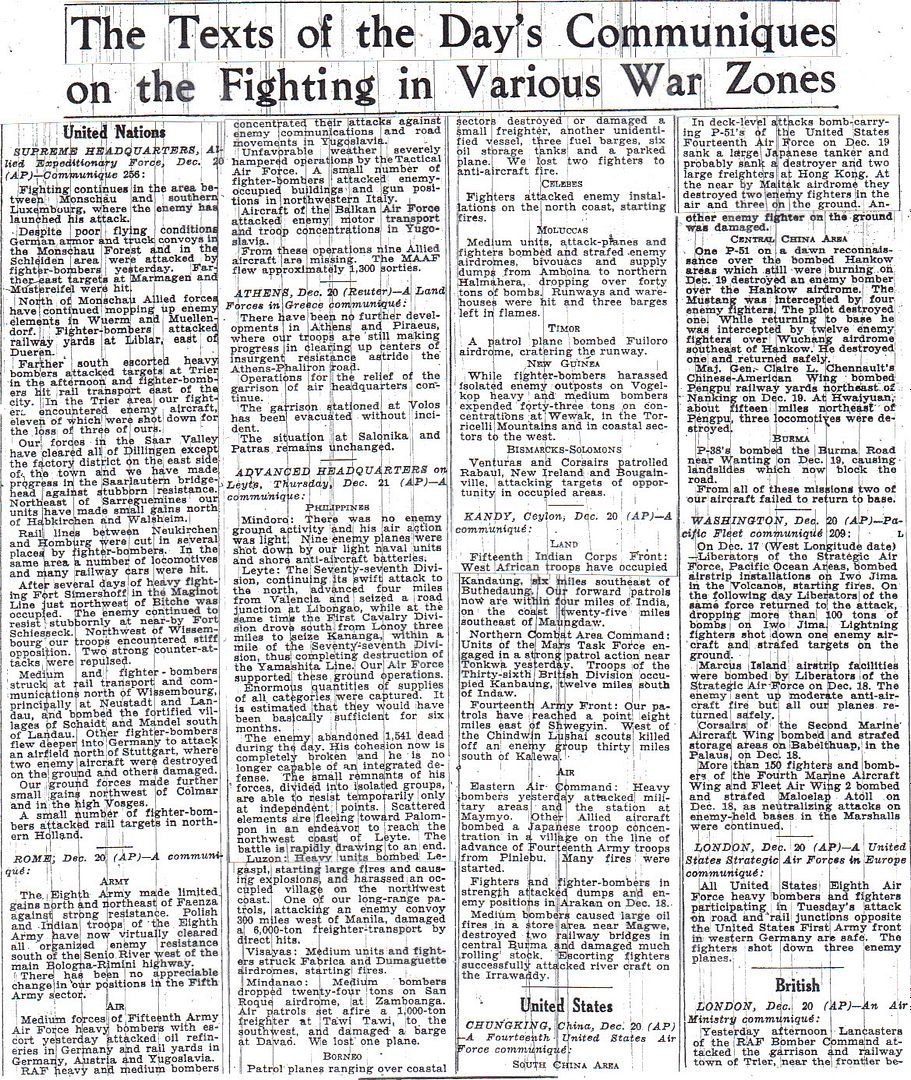

“The Ormoc Valley, in which the Japanese had so tenaciously resisted the American advance, was now securely in the hands of Sixth Army. The northern and southern prongs of the trap had closed. There remained only Palompon as an exit for the Japanese forces. To the securing of that port, the X and XXIV Corps, acting in concert, could concentrate their main efforts. Plans had been readied. The Sixth Army was poised in a position from which it could drive westward to the sea and bring the Leyte campaign to a successful conclusion.” (Cannon 346)
http://www.etherit.co.uk/month/11/21.htm
December 21st, 1944 (THURSDAY)
UNITED KINGDOM: Submarine HMS Spearhead commissioned.
BELGIUM:
“THE FOLLOWING PERSONAL DESCRIPTION OF THE BATTLE OF THE BULGE WAS WRITTEN BY General der Infanterie Heinz Kokott, Commanding General 26 Volks Grenadier Division which was attacking Bastogne. COMMENTARY IS BY JAY STONE WHO SERVED THERE WITH THE 101st AIRBORNE DIVISION.”
The US 101st Airborne has been almost completely surrounded at Bastogne. The US 82nd Airborne is pushed out of Hoffalize as the German offensive continues. US forces retake Stavelot and halts the German XLVII Corps.
General der Infanterie Heinz Kokott, Commanding General 26 Volks Grenadier Division:
“Towards 1000 hours the weather cleared up - for the first time since the start of the offensive.
“This had been dreaded by everybody [not by me] for it was well known what a clear day would mean! And after barely two hours, the first enemy fighter-bombers appeared in the sky - though not yet in great numbers!
‘With that moment, the enemy was able to bring a dreaded and very effective weapon into battle, and - on the basis of the assurances and promises which had been given by the very highest command to both the combat leaders and men prior to the offensive - it could only be hoped that this time the German air force could knock the enemy out of the skies!
“During the morning . . . Rifle Regiment 39 reported a successful advance . . . towards Assenois as well as fierce, but slowly progressing, fighting in the wooded terrain between Assenois and Villeroux. Everywhere the enemy fought determinedly and also made some counter attacks but was forced back steadily.”
The 26th Reconnaissance, along with elements of the 5th Infantry Parachute Division, seized Sibret during the dark, early morning hours.
“Bitter fighting had taken place - particularly inside the town [of Sibret] and around an anti-tank gun barricade in the southern part - and for a time the battle was fluctuating and dramatic. In the end, however, the brave defenders had succumbed to the incessant assault from all directions. Reconnaissance Battalion 26 stimulated by its success and the personal example set by the battalion commander kept at the heels of the withdrawing enemy and stormed into the enemy artillery which was then just ready for displacement in the area north of Sibert. In addition to a sizeable number of prisoners, more than 20 guns of all types with ammunition were captured, as well as a great number of tanks and armored vehicles with motors still running and also many truck and jeeps. The enemy had suffered bloody losses. The reconnaissance battalion’s losses had also been considerable.”
“On the afternoon of 21 December, the reinforced Rifle Regiment 39 fought its way up to Assenois against stubbornly fighting enemy forces and penetrated the southern part of the village. The Engineer Battalion and elements of the Replacement Training Battalion (subordinated to Rifle Regiment 39) were advancing further to the right and were fighting in the Bois Bechu Forest, or the southern part of the Bois Hazy Forest respectively, which resulted in loose contact with Regiment 901 of there Panzer Lehr Division, located between Remoifosse and Marvie.
“The enemy carried out several counterattacks which, though at times leading to critical situations for the Engineer Battalion and the Replacement Training Battaion could in the long run, always be checked.
“Reconnaissance Battalion 26 in its continued advance came across stubborn enemy resistance outside Senonchanps and at the same time was being attacked from the area north of Villeroux. The battalion was in quite a predicament, especially since those elements which had been committed for the protection of the left flank, had failed to get past enemy occupied Chenogne and were engaged in a battle for the village.
“With great difficulties and utmost effort only, the reconnaissance battalion, during fluctuating battles, was able to check the powerful armored counterthrusts of the enemy from the Senonchanps area and the north thereof as well as attacks from Villerous.
Team Brown, 420th Armored Field Artillery Battalion and tanks of CC B, 10th Armored Division were located in the Senonchamps areas. Also located in the path of Reconnaissance Battalion 26 was Battery B, 797th AAA-AW Battalion. Its calibre .50 ‘meatchoppers” help stopped the German advance on Sensonchamps. The counterthrusts were made by elements of and CC B, 10th Armored Division.
“The enemy pressure between Assenois and Villeroux also became so great by late afternoon that the attack by the left wing group of Rifle Regiment 39 towards Villerous gained ground with little progress only.
“A noticeable relief for the fighting of Reconnaissance Battalion 26 arrived by the early evening of 21 December, after Chebogne had been captured by the left flank covering party and after elements of the left wing group of Rifle Regiment 39 had at last pushed their way up between Assenois and Villerous to about the highway south to and past the railroad line soutwest of Villerous.
“Towards evening the enemy gave up his attacks against the right flank of Reconnaissance Battalion 26 and began to concentrate for a stubborn defence inside Villerous. Elements of Rifle Regiment 39 at first made futile attempts to attack these defenses. Late in the evening, “Reconnaissance Battalion 26 made several attempts - while neutralizing the enemy forces near Senonchamps - to push up to the north, or neartheast respectively, towards the Mande - St. Entienne road. Heavy fire from the north, however, as well as a number of furious enemy counterthrusts from the east, between Senonchamps and the highway, prevented these elements from reaching the road and from ‘digging in’ on both sides of the road.
“Late in the evening, the division, prompted by the mounting losses of Reconnaissance Battalion 26, ordered these attacks against the road to be discontinued temporarily.. The division could afford this after it had been found that the reconnaissance battalion had the northern and northeaster edges of the Bois de Fragotte - and Bois de Valet Forests well in hand and that it was in a position to dominate the Bastogne - Ortheuville road [to the west]with fire and at least hinder traffic.”
To the north and northeast of Bastogne the day was quiet. The Germans had apparently decided that there was no road through the 506th and 501st to Bastogne. For the next few days the action would be in the areas to the south and southwest of Bastogne. (Jay Stone)
Operational control of the USAAF Ninth Air Force’s IX Tactical Air Command and XXIX Tactical Air Command (Provisional) is transferred to the RAF Second Tactical Air Force to operate against the northern line of the Bulge. Weather grounds all operations.
The U.S. Ninth Army is reinforced by the British 51st Division as its zone expands. XIX Corps releases the 2d Armored Division to the U.S. First Army; takes over the VII Corps sector at 2400 hours. Under its command, in current positions, are the 104th, 83d, 5th Armored (less Combat Command R), 8th, and 78th Infantry Divisions, from north to south. XIII Corps takes over the former XIX Corps front and the 29th Infantry Division. The XVI Corps releases 75th Infantry Division to the U.S. First Army.
In U.S. First Army area, Regimental Combat Team 60, 9th Infantry Division, is detached from the 104th Infantry Division and moves to Ouffet. The corps is to operate next against the northern flank of the German salient. Combat Command A, 3d Armored Division, reverts to its parent unit and moves from Eupen to the Werbomont area. 1st Infantry Division contains further attacks toward Elsenborn ridge. In the XVIII Corps (Airborne) area, Combat Command B, 7th Armored Division, withdraws from St Vith at night; Combat Command A contains an attack near Poteau; Combat Command R clears the Vielsalm-Poteau road. Combat Command B, 9th Armored Division, is attached to the 7th Armored Division. The 82d Airborne Division’s 504th Parachute Infantry Regiment clears Cheneux and Monceau, forcing the Germans back across the Amblve River; the 505th Parachute Infantry Regiment improves positions from the Salm River at Trois Ponts to the vicinity of Grand Halleux; the 508th Parachute Infan try Regiment and 325th Glider Infantry Regiment occupy the line Vielsaim-Hebronval-Regn, making no contact with the Germans; the division makes contact with friendly troops in the St Vith area. The 30th Infantry Division is unable to take La Gleize and Stoumont and continues to defend Stavelot and Malmedy. The 3d Armored Division, to which Combat Command A reverts, contains the Germans at Hotton and continues efforts to secure the Manhay-Houffalize road. The 84th Infantry Division is organizing perimeter defense of Marche.
In the U.S. Third Army’s VIII Corps area, the Germans lay siege to Bastogne and extends westward; crosses the Neufchâteau-Bastogne highway in force. Ammunition and food supplies of the Bastogne garrison are running low. Provisional Corps troops are transferred to the XII Corps. Combat Command A, 10th Armored Division, tries unsuccessfully to recover Waldbillig. Combat Command A, 9th Armored Division, and Combat Command R, 10th Armored Division, are formed into Combat Command X, 10th Armored Division.
LUXEMBOURG: In the U.S. Third Army’s VIII Corps area, the 4th Infantry Division repels attacks toward Consdorf and Osweiler but is out of communication with troops in Echternach. Regimental Combat Team 50, 5th Infantry Division, is attached to the 4th Infantry Division. The XII Corps opens a forward command post in Luxembourg. The 35th Infantry Division’s relief is completed.
FRANCE: SS Lt-Col Otto Skorzeny leads the 150th Panzer Brigade in a pre-dawn attack on Malmedy.
Alsace - Task Force Hudelson (CCA, 14th Armored Division) was assigned a 10 mile front in the Vosges Mountains as divisions had been sent North to the Ardennes. Barbed wire was strung, fox holes and trenches were dug in the frozen ground. Sand bag racks had been welded on tanks so a layer of sand bags could help stop 88’s and panzerfausts.
Orders were to give ground rather than permit a break through like the Ardennes. Trees along roads were notched and prepared with explosives for road blocks, anti-vehicle mines were laid.
Prisoners taken boasted that the Germans would retake all of Alsace German artillery was registering one or two rounds at each crossroads, and village.
The weather was very cold, rain and snow. The Germans were moving large numbers of troops into position during periods of bad weather. (Joe Brott)
GERMANY: In U.S. First Army area, Combat Command A, 5th Armored Division, pushes about half way through Schneidhausen; Combat Command B gains approximately half of Untermaubach. In the V Corps area, the 9th Infantry Division, reinforced by the 102d Cavalry Group (Mechanized), rounds up Germans in the Monschau area. The 99th Infantry Division breaks up German formations with artillery fire.
Eighty four USAAF Fifteenth Air Force B-24 Liberators bomb the main marshalling yard and railroad sidings at Rosenheim with the loss of one B-24; 40 P-51 Mustangs provide escort. Over 40 P-38 Lightnings fly photo reconnaissance and reconnaissance escort missions.
During the day, 94 RAF Bomber Command Lancasters again attempt to bomb the railway yards at Trier in two waves. The bomber crews are unable to observe results because of the cloud cover, although a large column of smoke eventually appears.
During the night of 21/22 December, RAF Bomber Command dispatches 207 Lancasters and a Mosquito to attack the Hydrierwerke synthetic-oil refinery at Politz, near Stettin; 183 aircraft attack with the loss of three Lancasters and five more crash in England. Post-raid reconnaissance shows that the power-station chimneys had collapsed and that other parts of the plant are damaged. In a second mission, 136 aircraft, 67 Lancasters, 54 Halifaxes and 15 Mosquitos, are dispatched to bomb the Nippes marshalling yard (M/Y) at Cologne; this M/Y is being used to serve the German offensive in the Ardennes. One hundred aircraft attack the target but it is cloud-covered and only a few bombs hit the railway yards but these cause the destruction of 40 wagons (cars), a repair workshop and several railway lines. In a third strike, 97 Lancasters and 17 Mosquitos attempt to attack railway areas in Bonn; 108 attack but thick cloud cover prevents an accurate raid and later reconnaissance shows that the railway target is not hit. No other details are available. A raid is flown by four Lancasters to Schneidemuhl as a diversion to the Politz raid. Finally, 19 RAF Bomber Command aircraft lay mines off Swinemunde in the Baltic Sea.
U-1405, U-3011 commissioned
U-3044 laid down.
HUNGARY: Berlin reports fierce fighting southwest of Budapest between Lake Balaton and the Danube River where troops of the Soviet Third Ukrainian Front are again on the offensive. The Germans continue to withdraw from the Balkans.
ITALY: In the British Eighth Army’s Polish II Corps area, the 5th Kresowa Division, having relieved the 3rd Carpathian Division, begins mopping up east of the Senio River. V Corps continues to clear northward astride the Naviglio Canal. The Canadian I Corps overruns Bagnacavallo and reaches the Senio River in the Cotignola-Alfonsine area, but the Germans retain positions along the river on both flanks.
Bad weather grounds the USAAF Twelfth Air Force medium bombers and reduces fighter and fighter-bomber operations of the XXII Tactical Air Command however, aircraft are effective against railroad targets in the Treviso area and damage Ghedi Airfield. Trains, vehicles, guns, and buildings are attacked in or near La Spezia, Mantua, Mestre, Milan, Padua and Turin. During the night of 21/22 December, A-20 Havocs hit scattered targets in the Po Valley
YUGOSLAVIA: Thirty four RAF aircraft of No. 205 (Heavy Bomber) Group bomb two targets at Majkovac: 26 hit tactical targets while eight bomb a highway bridge.
CHINA: One hundred forty five USAAF Fourteenth Air Force P-40s and P-51 Mustangs fly armed reconnaissance over wide expanses of southern China, eastern Burma and northern French Indochina. The fighters attack chiefly troops and river, road, and rail traffic and a variety of targets of opportunity at numerous locations. Nine B-25 Mitchells bomb Kunlong and Minkiang, China.
MANCHURIA: The USAAF Twentieth Air Force’s XX Bomber Command flies Mission 23: 49 B-29 Superfortresses from Chengtu, China, are dispatched to attack Mukden; 19 hit the primary objective (the Manchuria Airplane Manufacturing Company) but it suffers little damage and a nearby arsenal and rail yards are slightly damaged; eight other B-29s bomb alternate targets and targets of opportunity; they claim 21-6-19 Japanese aircraft; two B-29s are lost.
BURMA: In the Northern Combat Area Command (NCAC), the Chinese 114th Regiment, 38th Division, with orders to cut the Burma Road in the Ho-si area, is now near the U.S. 5332d Brigade (Provisional). The 5332d Brigade is composed of the Chinese 1st Separate Regiment and the U.S. 124th Cavalry Regiment (Special), 475th Infantry Regiment (Long Range Penetration, Special) and the 612th and 613th Field Artillery Battalions (75mm Pack Howitzer).
In the Allied Land Forces South East Asia (ALFSEA) area, the Indian XV Corps is making such rapid progress on the Arakan front that Admiral Louis Mountbatten, Supreme Allied Commander South East Asia Theatre, holds a commanders conference at Calcutta, India, to discuss exploitation and presents alternative plans for assault on Akyab. By this time, river craft have been launched in the Kalapanzin River to assist the Indian 24th Division.
Twelve USAAF Tenth Air Force B-25 Mitchells bomb a supply and personnel area at Magyidon, 13 P-47 Thunderbolts damage bridges at Hay-ti, Mong Long, and Pa-mao while rail targets of opportunity from Hsumhsai to Hsipaw are attacked by 12 P-47 Thunderbolts. Over 20 fighter-bombers hit troop concentrations at several points including Man Ka-lao and the general area east of the Shweli River and 12 P-47 Thunderbolts bomb and strafe the Lashio area.
VOLCANO ISLANDS: Twenty three USAAF Seventh Air Force B-24 Liberators bomb Iwo Jima. During the night of 21/22 December, four B-24s fly three harassment strikes against Iwo Jima.
EAST INDIES: In the Netherlands East Indies, USAAF Far East Air Forces B-25 Mitchells attack Goeroea, Anggai, and Lolobata on Halmahera Island.
NEW GUINEA: In Northeast New Guinea, Australian Beaufort fighter bombers attack the Japanese east of the Danmap River. The Japanese withdraw to the south and run into an ambush set up by a platoon of the 2/4th Battalion, 19th Brigade, 6th Division; 28 of 40 Japanese troops are killed.
COMMONWEALTH OF THE PHILIPPINES: On Leyte Island, the U.S. Sixth Army effects a junction between the X and XXIV Corps just south of Kananga at 1645 hours, opening Highway 2 from Ormoc to Pinamopoan and gaining complete control of the Ormoc Valley. In the X Corps area, the 12th Cavalry Regiment (Infantry) attacks and takes Kananga and makes patrol contact with the 77th Infantry Division to the south. In the XXIV Corps area, the 3d Battalion, 306th Infantry Regiment, 77th Infantry Division, continues east along the Palompon road to its junction with Highway 2, then north along the highway toward Kananga, making contact with Troop A of the 12th Cavalry Regiment (Infantry) at 1645 hours. The 307th Infantry Regiment reaches the road junction north of Libongao without trouble and assists the 306th Infantry Regiment. On the division’s western flank, the 1st Battalion, 306th Infantry Regiment, after a concentrated artillery preparation, takes the ridge commanding the Togbong River bridge site a nd outposts it but is driven off. In preparation for the next task of the 77th Infantry Division, a drive west and seizure of Palompon, artillery is emplaced near San Jose within range of Palompon.
On Mindoro Island, the Japanese, having received reinforcements by air for the defense of the island, attack a resupply convoy moving toward that island, destroying two tank landing ships (LSTs) and damaging other shipping. From the Pasugi-Pianag area, a patrol of guerrillas and the 503d Parachute Infantry Regiment sail north to Sabalayan; from there move on foot to Mamburao to reconnoiter toward Palauan and Abra de Ilog.
USAAF Far East Air Forces B-24 Liberators, B-25 Mitchells, and fighter-bombers attack ten airfields mostly on Negros Island and elsewhere in the central Philippine Islands. Leyte Island-based fighter-bombers fly over 100 attack sorties. Likanan Airfield on Mindanao Island is also hit by B-24s.
The US X Corps meets the XXIV Corps in the middle of Ormoc Valley on Leyte. With only isolated groups of Japanese holding out in this area, organized resistance is ending.
Private First Class George Benjamin Jr., of the US Army, Company A, 306th Infantry, 77th Infantry Division, a radio operator left his comparatively secure position when a rifle platoon was held up by a Japanese strong point to guide his platoon to a light tank and then penetrated intense machine-gun and rifle fire to take the enemy position. He is mortally wounded. MOH
CANADA: Submarine HMS L-26 paid off Halifax, Nova Scotia.
U.S.A.: Washington: Henry H. Arnold is promoted to the rank of General of the Army.
Destroyer USS George K Mackenzie laid down.
Horse racing is banned until after World War II.
In baseball, the Detroit Tigers’ pitcher Hal Newhouser is named the American League’s Most Valuable Player; he won by four points. The National League’s Most Valuable Player award goes to St. Louis Cardinals’ shortstop Marty Marion. Marion tallies one more vote than Chicago Cubs right fielder Bill Nicholson. Led by Marion, the Cardinals erred only 112 times and averaged a .982 fielding average. Both marks top the previous records held by the 1940 Cincinnati Reds.
ATLANTIC OCEAN: During the night of 21/22 December, nine RAF Bomber Command aircraft lay mines in the Kattegat, the broad arm of the North Sea between Sweden and Denmark
U-806 sank SS Samtucky in Convoy HX-327.
U-995 sank MV Reshitel´nyj.
On the north shoulder of the Bulge the 6th SS Panzer Army has been stymied on the Elsenborn Ridge. The American 99th, 2nd and 1st infantry divisions with help from e3rd Armored Division have packed the North shoulder to deny 6th SS Panzer army the routes to the Meuse.
Kampfgruppe Peiper just to the south and west of Elsenborn Ridge is quickly running out of options. Low on fuel and ammo Peiper is being hemmed in by elements of the 3rd armor, 30th Infantry Division and 82nd Airborne along with various other units notably elements of the 1111th Combat Engineers.
St. Vith is under heavy pressure and will be abandoned by the US forces today. But the forces in St Vith just fall back slightly still denying the Germans free range of movement on the road net from St. Vith.
In the center The 5th Panzer Army is making headway when they can get fuel and supplies. Units of the 5th Panzer Army have gone past St. Vith to the south and are threatening Manhay and La Rouche. In Bastonge The 101st Airborne is arriving to reinforce CCB of the 10th Armored Division so as to deny the town with it’s valuable roadnet to the Germans. By now the Germans have decided to shift their man effort from 6th SS Panzer Army to the 5th Panzer Army!
In the south the German 7th Army has just about shot it’s bolt and is starting to go over to the defensive to prepare for the expected counterattack by Patton’s 3rd Army.
While the situation is starting to stabiles for the Americans at this time there is still much that could go wrong. If only the weather would break but that is still a few days off.
Regards
alfa6 ;>}
A brief review of the fuel issues that the combatants faced during the Battle of the Bulge.
By the time of the Watch on the Rhine offensive the Germans were forced to fight a poor mans war. After five years of war and a punishing Allied Strategic Air offensive it was getting difficult for the German Army to get sufficient allocations of ammunition and particularly fuel.
By December of 1944 the Germans had lost the Polesti oil fields which represented 25% of the Germans oil supply. The synthetic oil plants which had been under sporadic bombardment since before D-Day have had their production curtailed by roughly a third.
Despite these losses the German High Command through scrounging and hoarding since October of 1944 had amassed a fuel reserve of some 5 million gallons for the Watch on the Rhine offensive!
German staff planners used as measure of the operational fuel reserves a unit called “Verbauchssatze” or VS for short. A VS was the amount of fuel that a formation would use to move 100 kilometers under optimum conditions. Filedmarshal Model had requested 5 VS for the units before the jumpoff but on December 15th at bets there was only 1 VS on hand. Any units had less than that. Emergency orders were put in but still on the December 16th on about 1.5 VS were on hand in the forward depots.
To give the reader some idea of fuel consumption here is a table to follow:
Tank Type Good Roads:MPG Bad Roads:MPG Battalion Use N.B.
Pzkpw Mk IV 0.78 0.39 6,154gals
Pzkpw Mk V 0.64 0.32 7,500gals
Pzkpw Mk VI 0.44 0.22 10,909gals
M4A1 "Sherman" 0.7 0.35 6,857gals
Note Bene this is the amount of fuel needed to move a battalion of 48 tanks 50 miles in the Ardennes. This does not include any support vehicles so add about a 30% to the totals above for a more accurate measure.
The Germans were desperately short of motorized transport in December of 1944. Truck losses from January to October 1944 amounted to almost 110,00 vehicles. This was equal to the entire 1943 production and meant a loss of 40% of military transport capacity. A loss not easily made up by the overtaxed German manufacturing base . This left the Germans with an ageing fleet of vehicles and a mix of captured trucks. And spare parts wer in short supply at best and usually non existent in the case of the captured units.
As mentioned yesterday the Germans had quite the stockpile of Gas on the EAST side of the Rhine where it was a one day drive to get the fuel to the front. Once the offensive kicked off that time expanded to two days and after the 23rd of December when the Allied Airpower made it’s appearance the time was as much as 4 days. There were case after case of German unit leaders begging for fuel to get the panzer units moving yet at best they could only get a battalion of tanks instead of the whole unit on the move. And there is nothing worse than committing an armored unit piecemeal and sacrificing the massive punch that the unit as a whole can provide.
So much for the Germans now a quick look at the American supply picture. After the shortages in September and October the Americans had built up a pretty extensive supply stockpile. Yes there were still spot shortages, especially in winter clothing, but overall the Allies were in really good shape supply wise.
Here is where the Americans secret weapon comes in to play, the truck company! The American Army was almost awash in trucks a quick example. From December 17th to December 23rd the US 3rd Army used 133,178 trucks to move 6 Infantry divisions, 3 armored divisions, 25 field artillery battalions and 42,000 tons of supplies. This was done over 100 miles of icy roads into the wake of the German offensive. Surely the 3rd Army was low on fuel after all this but no, 3rd Army fuel stocks stood at over 2.8 million gallons at the end of December and this was after 1.5 million miles of vehicle travel in the two weeks of getting 3ed Army repositioned.
Information for this was from the book Battle of the Bulge: Hitlers Ardennes Offensive 1944-1945 by Danny S. Parker Materialschlacht or the War of Supply!
A brief review of the logistical issues that the combatants faced during the Battle of the Bulge.
By the time of the Watch on the Rhine offensive the Germans were forced to fight a poor mans war. After five years of war and a punishing Allied Strategic Air offensive it was getting difficult for the German Army to get sufficient allocations of ammunition and particularly fuel.
By December of 1944 the Germans had lost the Polesti oil fields which represented 25% of the Germans oil supply. The synthetic oil plants which had been under sporadic bombardment since before D-Day have had their production curtailed by roughly a third.
Despite these losses the German High Command through scrounging and hoarding since October of 1944 had amassed a fuel reserve of some 5 million gallons for the Watch on the Rhine offensive!
German staff planners used as measure of the operational fuel reserves a unit called “Verbauchssatze” or VS for short. A VS was the amount of fuel that a formation would use to move 100 kilometers under optimum conditions. Filedmarshal Model had requested 5 VS for the units before the jumpoff but on December 15th at bets there was only 1 VS on hand. Any units had less than that. Emergency orders were put in but still on the December 16th on about 1.5 VS were on hand in the forward depots.
To give the reader some idea of fuel consumption here is a table to follow:
Tank Type Good Conditions: level ground, good roads / MPG Ardennes Conditions: hilly terrian, bad roads / MPG Battalion Use N.B. Pzkpw Mk IV 0.78 0.39 6,154 Pzkpw Mk V "Panther" 0.64 0.32 7,500 Pzkpw Mk VI "Tiger" 0.44 0.22 10,909 M4A1 "Sherman" 0.7 0.35 6,857
Note Bene this is the amount of fuel needed to move a battalion of 48 tanks 50 miles in the Ardennes. This does not include any support vehicles so add about a 30% to the totals above for a more accurate measure.
The Germans were desperately short of motorized transport in December of 1944. Truck losses from January to October 1944 amounted to almost 110,00 vehicles. This was equal to the entire 1943 production and meant a loss of 40% of military transport capacity. A loss not easily made up by the overtaxed German manufacturing base . This left the Germans with an ageing fleet of vehicles and a mix of captured trucks. And spare parts wer in short supply at best and usually non existent in the case of the captured units.
As mentioned yesterday the Germans had quite the stockpile of Gas on the EAST side of the Rhine where it was a one day drive to get the fuel to the front. Once the offensive kicked off that time expanded to two days and after the 23rd of December when the Allied Airpower made it’s appearance the time was as much as 4 days. There were case after case of German unit leaders begging for fuel to get the panzer units moving yet at best they could only get a battalion of tanks instead of the whole unit on the move. And there is nothing worse than committing an armored unit piecemeal and sacrificing the massive punch that the unit as a whole can provide.
So much for the Germans now a quick look at the American supply picture. After the shortages in September and October the Americans had built up a pretty extensive supply stockpile. Yes there were still spot shortages, especially in winter clothing, but overall the Allies were in really good shape supply wise.
Here is where the Americans secret weapon comes in to play, the truck company! The American Army was almost awash in trucks a quick example. From December 17th to December 23rd the US 3rd Army used 133,178 trucks to move 6 Infantry divisions, 3 armored divisions, 25 field artillery battalions and 42,000 tons of supplies. This was done over 100 miles of icy roads into the wake of the German offensive. Surely the 3rd Army was low on fuel after all this but no, 3rd Army fuel stocks stood at over 2.8 million gallons at the end of December and this was after 1.5 million miles of vehicle travel in the two weeks of getting 3ed Army repositioned.
Information for this was from the book Battle of the Bulge: Hitlers Ardennes Offensive 1944-1945 by Danny S. Parker
Regards
alfa6 ;>}
“The amateurs discuss tactics: the professionals discuss logistics.”
– Napoleon Bonaparte
The Glamour of Logistics:
"The next day we started moving back and they told us we were going to operate on the Red Ball, so we did. What a grind that turned out to be, and we would haul from either the beaches or Cherbourg all the way across France. Many times (we hauled) as far as Belgium and it took several days to complete this, and the trucks would break down and all kinds of trouble developed every day. Just the same, plenty of supplies were moved this way and all of it was worthwhile. We were not on the Red Ball too many weeks before the railroads were getting in operation, and soon they replaced the trucks in this sector, so we moved again.
This time we went north to Rouen, and this was all British territory and at first it was a little difficult to do things as they did. In fact, we did not do things their way, but our way, as it was only a matter of time before the yanks had control of the whole situation in that city. While here we operated on the White Ball highway system, which was similar to the Red Ball, only not on such a large scale.
Many of our trips were to Paris, and many times we lost men in that city, as there were too many good times to be had there. It was October when we moved into a field north of Rouen and the fall rains were just starting; in less than ten days we were in mud almost up to our necks and every day it became worse (as it rained every day). The trucks would run off the side of the narrow road through our area and soon they had holes so deep they could not get through them. One hole was so deep that a truck would nearly upset when it got in there, and it always took at least two more trucks to pull one (truck) out of that place. We tried to fill that hole with rock, and finally gave up after hauling rock into it for three days. We would slip and slide through the mud over to the kitchen truck, get our chow, take it back to our tent and eat it in there where it was warm. We had some German prisoners doing work for the company at this time, and they were good workers, too—and plenty handy to have around. Near the end of December and the first part of January it was plenty cold living in those tents, and many a morning our tent would have the ice frozen to the ceiling in places, and frost all over everything in it. Our drinking water in the water cans froze and it was COLD! We had a stove but had nothing but wood to burn, and it would only hold fire as long as someone sat near it and continuously put more wood in the stove."
Mr. niteowl77
“For want of a nail the shoe was lost, for want of a shoe the horse was lost; and for want of a horse the rider was lost; being overtaken and slain by the enemy, and all for want of care about a horse-shoe nail.”
Bottom of page 4, Mary Louise Rutte, Queen of the Tournament of Roses parade. Picture doesn’t copy, but you can see her here:
http://www.tribunephotos.com/Photo-Louise-Rutte-Tournament-BPM-893-BS/dp/B00BI5XDP0
Bottom of Page 6: “Nazi Counter-Offensives In December a Tradition”
German attacks through the impassible Ardennes were a tradition, too. Why were we totally taken by surprise, again? (Rhetorical question ... we’ve already hashed it out.)
Pilgrim, that kind of talk would get ya killed in today's California. :)
(Page 5 NYT): “Price of Nazi Attack Aids Us In Final Strategy, Observers Say”
Interesting. I wonder if some have thought that instead of lengthening the war, the desperate Nazi offensive might have actually shortened the war because after this flash in the pan, they didn’t have much left.
“There’s absolutely no reason for us to assume that the Germans are mounting a major offense. The weather is awful and their supplies are low. The Germans haven’t mounted a winter attack since Frederick the Great. Therefore I believe that’s exactly what they’re going to do.”
- Quote from the movie Patton. Not sure how historically accurate Patton was but my guess is, if Patton actually said this, that it was probably pretty accurate.
Read page 6 of today’s post: “Price to Nazis of Attack Aids Us In Final Strategy, Observers Say.
Actually, Eisenhower’s first reaction to the attack was just that, “The present situation is to be regarded as one of opportunity for us and not of disaster.” They would engage the Wehrmacht on the march, exposed on roads instead of fighting in ambush behind prepared positions. A German general, I forgot whom, said that the Americans in the Ardennes performed the artillery preparation for the Battle of Berlin.
At the conference at SHAEF HQ, where Patton made his commitment to attack in the German flank in 48 hours...
Turning toward Bradley as he described his plans for the southern shoulder of the Bulge, Patton contended, “Brad, the Kraut’s stuck his head in a meat grinder. And”—he turned his fist in simulation—“this time I have hold of the handle.” - See more at: http://www.historynet.com/battle-of-the-bulge#sthash.2DCFLSJR.dpuf
Interesting. Thanks for the link.
Just when I think maybe I’m being to hard on Monty, I read something like this regarding the council of generals at Verdun (sans Monty): “Monty would not deign to travel to meet with lower ranks than his own.”
I can’t believe that guy.
Disclaimer: Opinions posted on Free Republic are those of the individual posters and do not necessarily represent the opinion of Free Republic or its management. All materials posted herein are protected by copyright law and the exemption for fair use of copyrighted works.